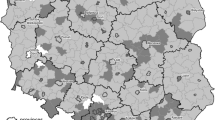Abstract
We construct a simple model incorporating bothcitizen-candidates and proportional representation andinvestigate its properties in a basic case with auniform distribution of citizen ideal points and purepolicy motivations, and in further cases which allowof office rents and other distributions ofpreferences. The idea of citizen-candidates, developedby Osborne and Slivinski (1996), Besley and Coate(1997), endogenises the decision to stand as acandidate and allows explicit study of the number andtype of candidates as an equilibrium phenomenon. Theidea of proportional representation allows a moreflexible relationship between the pattern of votescast and the final policy outcome, and also providesa richer model of political representation. Ourdiscussion points to the widespread possibility ofequilibria involving non-median policy outcomes;provides insights into the relationship betweenproportional representation and the equilibrium numberof candidates; and also provides an explicit accountof the trade-off between candidate benefitsdistributed on a winner-take-all basis and those thatare mediated through proportional representation.
Similar content being viewed by others
References
Aldrich, J. (1993). Rational choice and turnout. American Journal of Political Science 37: 246–278.
Alesina, A. (1988). Credibility and policy convergence in a two-party system with rational voters. American Economic Review 78: 796–806.
Alesina, A. and Rosenthal, H. (1996). Partisan politics, divided government and the economy. Cambridge: Cambridge University Press.
Austen-Smith, D. and Banks, J. (1988). Elections, coalitions and legislative outcomes. American Political Science Review 82: 407–422.
Besley, T. and Coate, S. (1997). An economic model of representative democracy. Quarterly Journal of Economics 112: 85–114.
Brennan, G. and Hamlin, A. (1998a). Expressive voting and electoral equilibrium. Public Choice 95: 149–175.
Brennan, G. and Hamlin, A. (1998b). On political representation. British Journal of Political Science (in press).
Brennan, G. and Lomasky, L. (1983). Democracy and decision. Cambridge: Cambridge University Press.
Chamberlin, J. and Courant, P. (1983) Representative deliberation and representative decisions: Proportional representation and the Borda Rule. American Political Science Review 77: 718–733.
Downs, A. (1957). An Economic theory of democracy. New York: Harper and Row.
Gerber, A. and Ortuno-Ortin, I. (1996). Political compromise and endogenous formation of coalitions, mimeo.
Hotelling, H. (1929). Stability in competition. Economic Journal 39: 41–57.
Ledyard, J. (1984). The pure theory of large, two-candidate elections. Public Choice 44: 7–41.
Mueller, D. (1989). Public choice II. Cambridge: Cambridge University Press.
Ortuno-Ortin, I. (1997). A spatial model of political competition and proportional representation. Social Choice and Welfare 14: 427–438.
Osborne, M. and Slivinski, A. (1996). A model of political competition with citizencandidates. Quarterly Journal of Economics 111: 65–96.
Palfrey, T. (1984). Spatial equilibrium with entry. Review of Economic Studies 51: 139–156
Schultz, C. (1996). Polarization and inefficient policies. Review of Economic Studies 63: 331–343.
Tullock, G. (1967) Toward a mathematics of politics. Ann Arbor, University of Michigan Press.
Weber, S. (1992). On hierarchical spatial competition. Review of Economic Studies 59: 407–425.
Author information
Authors and Affiliations
Rights and permissions
About this article
Cite this article
Hamlin, A., Hjortlund, M. Proportional Representation with Citizen Candidates. Public Choice 103, 205–230 (2000). https://doi.org/10.1023/A:1005086519491
Issue Date:
DOI: https://doi.org/10.1023/A:1005086519491




